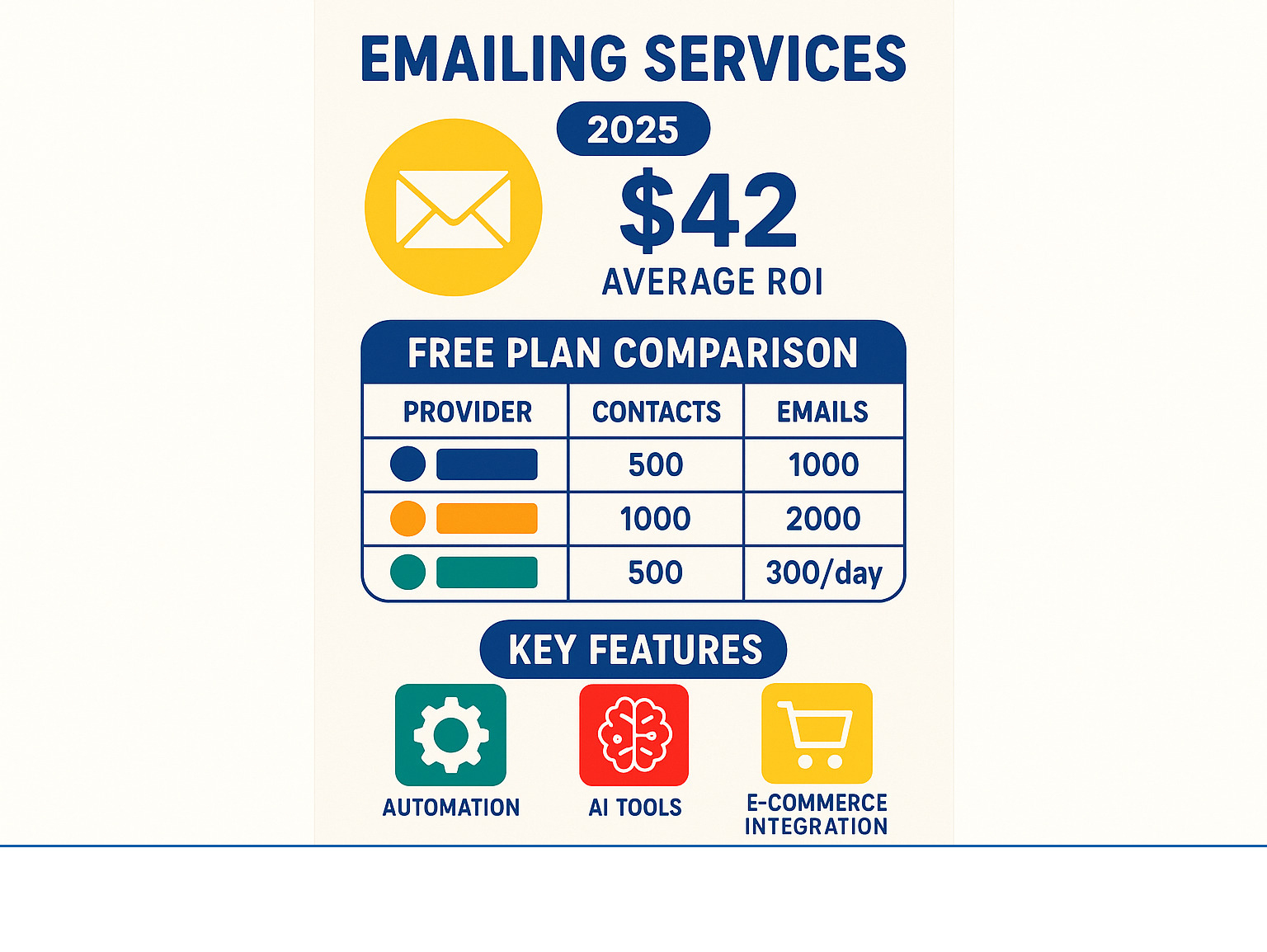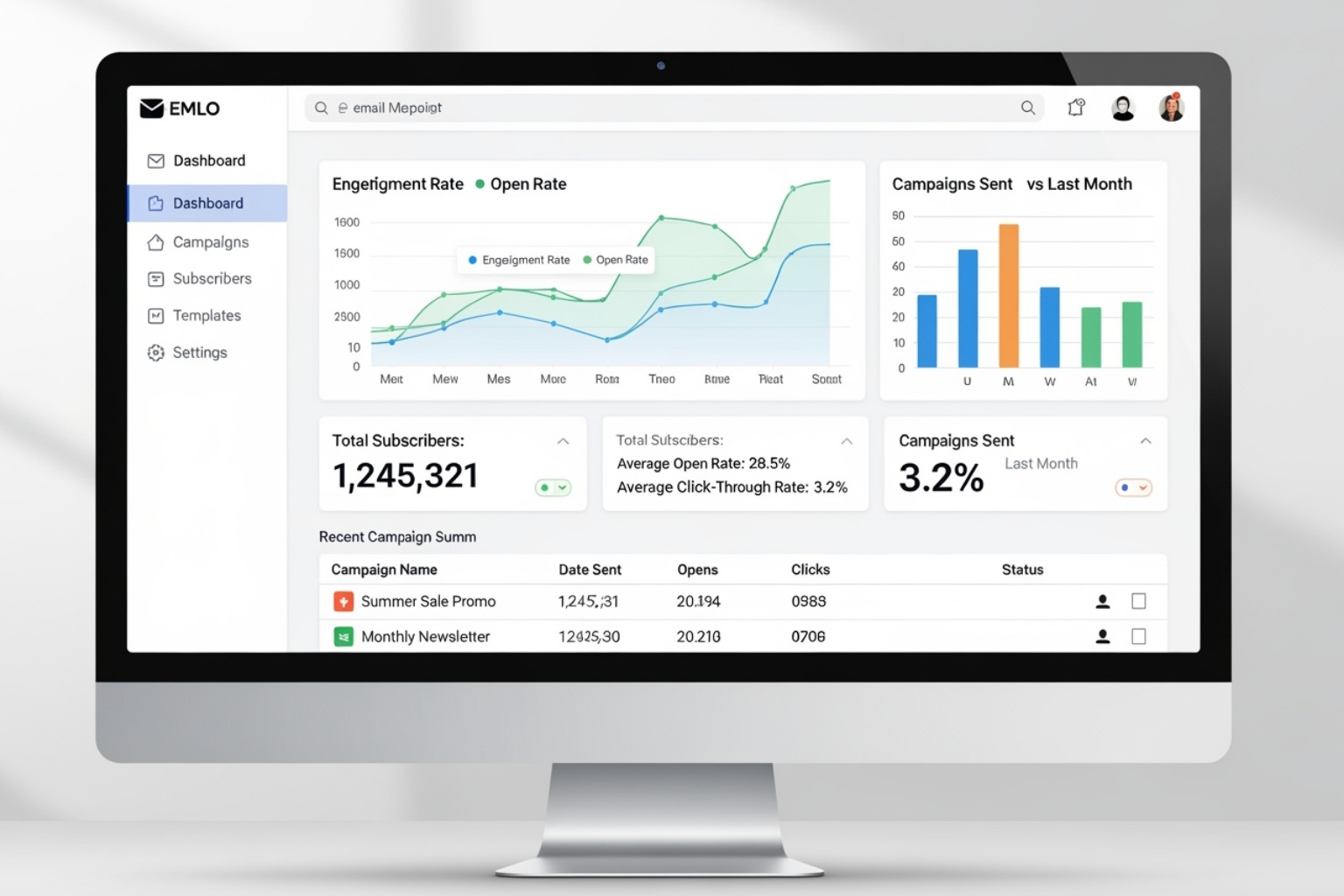Why Choosing the Right Emailing Service Matters for Your Business
Emailing services are the backbone of successful digital marketing, with businesses seeing up to 25x ROI from well-executed email campaigns. For e-commerce leaders looking to scale their operations, selecting the right platform can mean the difference between stagnant growth and exponential success.
Top emailing services to consider:
- Mailchimp - 11M+ users globally, AI-powered features, up to 25x ROI
- Klaviyo - E-commerce focused, advanced automation, SMS integration
- HubSpot - All-in-one CRM platform, 2,000 free emails monthly
- Brevo - Marketing automation included, 300 free emails daily
- MailerLite - Simple interface, free for 1,000 contacts
- GetResponse - Website builder included, 30-day free trial
Email marketing has progressed far beyond simple newsletters. Modern emailing services offer sophisticated automation, AI-powered personalization, and deep e-commerce integrations that can change how you connect with customers. With email marketing delivering $42 for every $1 spent according to recent studies, choosing the wrong platform could cost you thousands in missed opportunities.
Whether you need abandoned cart recovery, advanced segmentation, or multichannel campaigns combining email and SMS, different platforms excel in different areas. Some shine for beginners with drag-and-drop simplicity, while others offer enterprise-grade features for scaling businesses.
I'm Steve Pogson, and over the past two decades, I've helped leading brands like Wyman's Blueberries and Hyperlite Mountain Gear optimize their emailing services to drive significant revenue growth. Through my work at First Pier, I've seen how the right email platform can change a business's customer relationships and bottom line.

Must-know emailing services terms:
What to Look for in an Emailing Service
When I help clients choose an emailing service, I always start with the basics: what will you actually use every day? The email editor is your creative workspace, so it needs to feel intuitive. You want drag-and-drop functionality that doesn't require a design degree, plus templates that look professional on every device. I've watched business owners go from spending hours wrestling with email design to creating beautiful campaigns in minutes with the right editor.
List management might sound boring, but it's where the magic begins. Beyond simply adding and removing contacts, you need powerful segmentation capabilities. This is what separates amateur email marketing from the strategies that drive real business growth. Instead of blasting the same message to everyone, you can create targeted campaigns based on purchase history, browsing behavior, or customer preferences.
Smart segmentation changes your customer relationships and boosts lead generation. Think of it this way: would you rather send a generic "Hey everyone!" message or a personalized note that speaks directly to what each customer cares about? For a deeper look at building these targeted strategies, check out a guide to email marketing strategy.
Deliverability is where many businesses stumble without realizing it. Your emails need to actually reach inboxes, not disappear into spam folders. I always examine a platform's sender reputation and their track record for getting past spam filters. This connects directly to uptime and reliability – your campaigns must go out when scheduled, every single time.
Security and compliance aren't just nice-to-haves anymore; they're essential for protecting your business and your customers' trust. Your emailing service should handle GDPR requirements automatically, making it easy to manage consent and provide clear unsubscribe options. The platform should also protect sensitive customer data with enterprise-grade security measures. For more details on how platforms help with GDPR compliance, there are excellent resources available to guide you through the requirements.
The right emailing service grows with your business, handling these technical details so you can focus on creating campaigns that connect with your audience and drive results.
A Look at the Top Emailing Services

After working with dozens of emailing services over the years, I've learned that finding the right platform is like finding the perfect pair of jeans – what fits one business perfectly might be completely wrong for another. The key is understanding your specific needs and matching them to a platform's strengths.
I like to think of emailing services in three main categories, each designed for different stages and types of businesses. Some excel at simplicity and getting you started quickly, others are built specifically for online stores, and some offer everything under one roof. Let's explore where each type truly shines.
Best Emailing Services for Beginners
When you're just starting out, the last thing you want is to spend hours figuring out how to send a simple newsletter. The best emailing services for beginners focus on ease of use above all else. They offer clean, simple interfaces that don't overwhelm you with dozens of buttons and options you don't need yet.
MailerLite is a perfect example of this approach. Its name says it all – it's designed to be "lite" without sacrificing the features you actually need. The drag-and-drop editor feels natural, almost like arranging photos in a scrapbook. You can create professional-looking emails in minutes, not hours.
Constant Contact takes a similar approach, earning its reputation for being incredibly straightforward. What I love about these platforms is their focus on pre-made templates that actually look good. You're not starting with a blank canvas wondering where to begin – you're choosing from designs that already work.
Customer support becomes crucial when you're learning the ropes. Some services offer impressive 24/7 support with response times as quick as five minutes on live chat. When you're stuck at 9 PM trying to send your first campaign, that kind of help is invaluable.
As you grow more confident, you'll want to start building your email list more aggressively. This is where features like popup forms become game-changers. If you're curious about creative ways to grow your list, check out this guide on using popup forms to grow your list. These tools can turn casual website visitors into involved subscribers.
Top Emailing Services for E-commerce
Running an online store changes everything about your email marketing needs. You're not just sending newsletters – you're recovering lost sales, recommending products, and building long-term customer relationships. This is where specialized e-commerce integration becomes essential.
Klaviyo stands out as the gold standard for online retailers. It's built specifically for e-commerce, offering advanced segmentation that lets you target customers based on exactly what they've bought, browsed, or even how much they're likely to spend in the future. The platform's deep Shopify integration is particularly impressive – it feels like they were designed to work together. For a detailed look at this integration, I recommend reading about connecting with Shopify.
Abandoned cart emails are where these platforms really show their value. Picture this: a customer loads up their cart with $200 worth of products, then gets distracted and leaves. A good e-commerce email service automatically sends a gentle reminder, often bringing them back to complete the purchase. It's like having a helpful store assistant who remembers every customer who walked away.
Omnisend is another strong choice for online stores, especially if you want to combine email and SMS marketing. Being able to send a quick text about a flash sale while also nurturing customers through email creates multiple touchpoints that can significantly boost your revenue.
Product recommendations within emails are another feature that separates e-commerce platforms from basic newsletter services. These systems can automatically suggest products based on past purchases or browsing behavior. For more insights on recovering early-stage browsers, explore this resource on browse abandonment emails.
All-in-One Marketing Platforms
Sometimes you need more than just email – you need a complete marketing toolkit. All-in-one marketing platforms extend far beyond traditional emailing services, offering everything from customer management to social media advertising in one integrated system.
HubSpot is the leader in this space, and for good reason. While it offers solid email marketing features, its real strength lies in its complete CRM capabilities. You can track every interaction with a customer, from their first website visit to their latest purchase, all in one place. This integrated approach means your sales and marketing teams are always on the same page.
These platforms typically include landing page builders, so you can create dedicated pages for your campaigns without needing separate software. Many also connect with social media ads, helping you create consistent messaging across all your marketing channels.
What I find particularly valuable about platforms like HubSpot's Marketing Hub is their extensive app marketplace. You can connect with hundreds of other business tools, creating a seamless workflow that saves time and reduces errors. Learn more about their complete approach at HubSpot's Marketing Hub.
The trade-off is complexity – these platforms can feel overwhelming if you just need to send weekly newsletters. But if you're ready to coordinate multiple marketing channels and want everything under one roof, they're incredibly powerful.
What Makes Them Different: Automation, AI, and Integrations

What really separates the good emailing services from the great ones? It's not just the basics anymore. The platforms that truly stand out are those offering sophisticated automation, smart artificial intelligence features, and seamless integrations with your existing tools. These advanced capabilities can change your email marketing from a time-consuming task into a revenue-generating powerhouse that works around the clock.
The Power of Automation
Think about your busiest day running your business. Now imagine if your email marketing could handle itself – sending the perfect welcome message when someone subscribes, dropping a friendly reminder about that abandoned cart, or reaching out to customers who haven't been involved in a while. That's exactly what automation does for you.
I've watched businesses completely change their customer relationships through smart automation. A welcome series introduces new subscribers to your brand story, building trust from day one. Campaigns to bring back inactive customers can wake up dormant customers who might have forgotten about you, often bringing them back for repeat purchases.
For Shopify store owners, automation becomes even more powerful. You can set up flows that trigger based on specific customer behaviors – like browsing certain products or hitting particular spending thresholds. If you're running a Shopify store, I highly recommend exploring using automation in Shopify to see how these tools can work for your specific setup.
The beauty of automation lies in creating personalized customer experiences at scale. Instead of sending generic emails to everyone, you can craft specific paths for different types of customers. New subscribers get one experience, VIP customers get another, and customers at risk of churning get targeted campaigns to bring them back. For inspiration on building these automated sequences, check out these ideas for the best email flows.
The Role of Artificial Intelligence (AI)
Artificial intelligence isn't just a fancy tech buzzword – it's becoming a practical tool that makes your emailing services smarter and more effective. I'm constantly amazed by how AI can analyze customer behavior patterns that would take humans weeks to identify.
Smart segmentation powered by AI can automatically group your customers based on their likelihood to purchase, their preferred shopping times, or even their risk of churning. This means you're not just guessing who might be interested in your latest promotion – you're targeting customers based on data-driven insights.
AI-powered content creation is another game-changer. Some platforms can now suggest subject lines that are more likely to get opened, or even help write email copy that resonates with specific audience segments. Subject line optimization through AI testing can significantly boost your open rates without any extra work on your part.
Klaviyo has been leading the charge in this area, offering AI tools that can predict customer lifetime value and suggest the best times to send emails to individual subscribers. You can explore Klaviyo's AI tools to see how artificial intelligence is being applied to real email marketing challenges.
The Impact of Integrations
Your emailing service shouldn't be an island – it needs to work seamlessly with all your other business tools. The best platforms understand this and offer robust integration capabilities that create a smooth workflow across your entire tech stack.
Connecting your tools means data flows automatically between systems. When someone makes a purchase on your e-commerce platform, that information should instantly update their profile in your email system. When a customer fills out a contact form, they should be automatically added to the right email list.
E-commerce platform integrations are particularly crucial. Your email service should sync perfectly with your online store, pulling in purchase history, browsing behavior, and customer preferences. This creates opportunities for highly targeted campaigns based on actual customer actions.
CRM software integration helps you maintain a complete picture of each customer relationship. When your sales team updates a customer record, your marketing automation can adjust accordingly. This prevents awkward situations like sending promotional emails to customers who just complained about a product issue.
Form builders and lead generation tools also play important roles in this ecosystem. Integrating with form builders like WPForms ensures that every contact form submission feeds directly into your email marketing system. Similarly, using lead generation tools like OptinMonster can help you capture more subscribers through targeted popups and forms that connect seamlessly with your email platform.
When all these tools work together well, you get a complete view of your customer experience and can respond with the right message at exactly the right moment.
Understanding Pricing and Free Options

When it comes to emailing services, understanding pricing can feel like learning a new language. Most platforms use subscription models that charge based on either the number of contacts you have or how many emails you send each month. Some services give you unlimited sends once you're in a contact tier, while others charge per email - especially for transactional messages.
Here's what I've learned from helping clients choose the right plan: always think about where your business is heading. That affordable plan for 500 contacts might shock you when you hit 10,000 subscribers. The pricing jumps between tiers can be significant, so it's smart to map out your growth expectations before committing.
Watch out for those sneaky extra costs too. Many platforms reserve their best features - like advanced automation, premium templates, or SMS marketing - for higher-tier plans. Others charge separately for things like dedicated IP addresses or priority customer support. It's not necessarily bad, but you want to know what you're getting into.
The per subscriber model tends to be more predictable for budgeting, while per send pricing can work well if you email infrequently but have a large list. Think about your typical email frequency when comparing options.
Comparing Free Emailing Services
The bright side? Many emailing services offer surprisingly generous free plans. These are perfect for testing the waters or getting started when money's tight. I've seen plenty of small businesses build solid email programs without spending a dime initially.
But free plans do come with trade-offs. Most limit your contact count and monthly sends. You'll also typically see the provider's branding in your emails - that little "Powered by [Platform Name]" footer that screams "I'm using the free version!" More importantly, advanced features like detailed analytics, automation workflows, and premium integrations usually require upgrading to a paid plan.
Here's a quick snapshot of what some popular services offer on their free tiers:
| Service | Contacts (Free Plan) | Monthly Sends (Free Plan) | Daily Sends (Free Plan) |
|---|---|---|---|
| Mailtrap | 100 | 3,500 (Sending), 100 (Testing) | - |
| Brevo | 500 | - | 300 |
| Mailchimp | 500 | 1,000 | - |
| MailerLite | 500 | 1,000 | - |
| HubSpot | 1,000 | 2,000 | - |
| Omnisend | 250 | 500 | - |
| Klaviyo | 250 | 500 | - |
Brevo stands out with its daily send model rather than monthly limits, which can work well for consistent senders. HubSpot offers the most generous contact allowance, while Mailtrap gives you more monthly sends but fewer contacts to work with.
The key is viewing these free plans as your training wheels, not your forever solution. As your business grows and you need more sophisticated features like behavioral triggers or advanced segmentation, you'll naturally graduate to a paid plan. But they're fantastic for learning the ropes and proving the value of email marketing to your business.
Frequently Asked Questions about Emailing Services
When I'm working with clients at First Pier, I hear the same questions about emailing services over and over again. These concerns are completely understandable – choosing the right platform feels like a big decision because, well, it is! Let me share the answers to the most common questions that keep business owners up at night.
How do I choose the right emailing service for my small business?
The secret to picking the perfect emailing service isn't finding the one with the most bells and whistles – it's finding the one that fits your actual needs and budget. I always tell my clients to start by being honest about what they can afford, not just today, but as they grow over the next year or two.
Next, think about your comfort level with technology. If you're already juggling a million tasks (and let's be real, most small business owners are), you don't need an email platform that requires a PhD to operate. Look for something with drag-and-drop editors, clean interfaces, and templates that actually look good without hours of tweaking.
Here's where it gets interesting for e-commerce businesses: even if you're small, you still need those power features like abandoned cart recovery and product recommendations. These aren't luxury add-ons – they're money-makers that can boost your revenue from day one. The integration with your store platform matters too, especially if you're on Shopify.
To keep yourself on track during setup, I've created a helpful checklist for Shopify email marketing that covers all the must-have features and steps you shouldn't skip.
How important is customer support when selecting a platform?
Customer support can make or break your experience with an emailing service, and I've seen this play out countless times with clients. Picture this: it's Black Friday, your biggest campaign of the year is about to go out, and something goes wrong. In that moment, having access to knowledgeable, responsive support isn't just nice to have – it's business-critical.
I've watched excellent support teams turn what could have been marketing disasters into minor bumps in the road. The best services offer 24/7 support through multiple channels like chat, email, and phone. This is especially valuable if you work odd hours or operate in different time zones than your platform's headquarters.
Before you commit to any platform, spend some time on review sites like G2 and Capterra. Look specifically for comments about support quality and response times. You'll quickly spot patterns – some companies consistently get praise for their helpful teams, while others... well, let's just say you'll want to avoid those headaches.
Can I switch emailing services later on?
Absolutely, and don't let anyone tell you otherwise! Switching emailing services is definitely possible, though I won't sugarcoat it – it's not always a walk in the park. Think of it like moving to a new house: doable, but it requires some planning and effort.
The straightforward part is moving your contacts. Most reputable platforms make it easy to export your subscriber list from one service and import it into another. Where things get trickier is rebuilding all your automations, email templates, and workflows. Your welcome series, abandoned cart sequences, and other automated campaigns will likely need to be recreated from scratch on your new platform.
Some services offer migration assistance, which can be a lifesaver. However, the more complex your current setup, the more time-consuming the switch becomes. I always recommend trying to choose wisely from the start, but don't let fear of switching trap you with a platform that's holding your business back. Sometimes the long-term benefits of a better-suited emailing service far outweigh the temporary hassle of making the change.
To Sum Up: Making Your Final Choice
After exploring emailing services together, from basic features and beginner-friendly platforms to e-commerce powerhouses and advanced automation tools, you might feel like there's a lot to consider. And you're right – there is! But here's the thing: there's no single "perfect" emailing service that works for every business out there.
The best platform for you is the one that fits your specific needs like a glove. Think of it like choosing a car – a sports car might be perfect for weekend trips, but a minivan makes more sense for a growing family.
When making your final decision, keep these essential factors in mind. Ease of use should be at the top of your list – you want a platform your team will actually enjoy using, not one that makes sending emails feel like solving a math problem. E-commerce features matter tremendously if you're selling products online; features like abandoned cart recovery and product recommendations can directly boost your sales.
Automation capabilities can be a game-changer, saving you countless hours while creating personalized experiences for your customers. Don't forget about pricing – make sure the costs line up with your budget and won't surprise you as your business grows. Finally, reliable support can make all the difference when you hit a roadblock or need guidance.
The right emailing service becomes more than just a tool – it becomes a trusted partner in growing your business. When chosen thoughtfully, it can strengthen customer relationships, increase sales, and give you back precious time to focus on what you do best.
If you're feeling overwhelmed by all the options or want help getting the most out of your email marketing efforts, you don't have to figure it all out alone. At First Pier, we've helped countless e-commerce businesses build stronger customer relationships through smart email and SMS strategies. When you're ready for expert guidance, get expert help with your email and SMS marketing.








